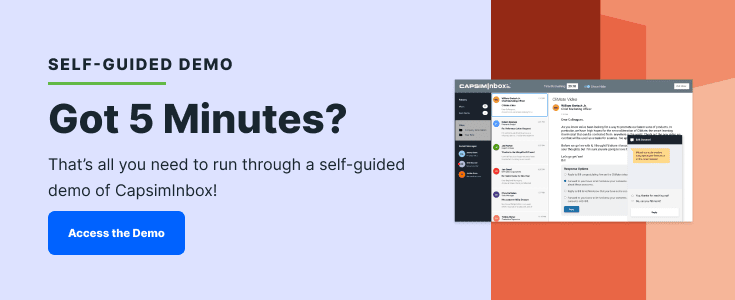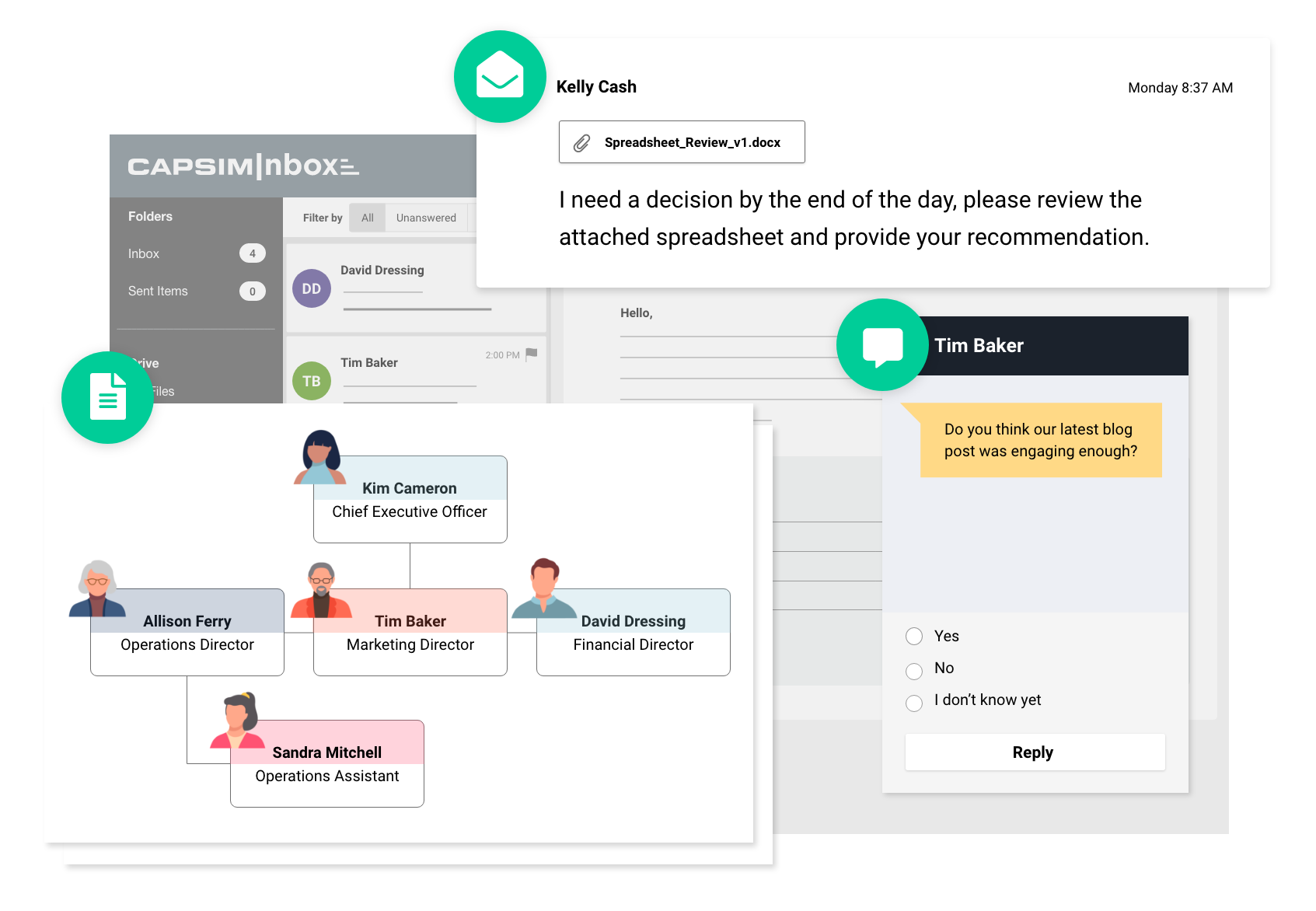Capitalize on These 5 Benefits of Experiential Learning with Inbox Simulations

August 16, 2022

Corporations spend thousands of dollars on learning and development initiatives each year.
After all that time and money is invested, however, only 12 percent of employees report using the business soft skills and hard skills they learned in training in their daily job duties. How can we solve this problem? One significant piece of the puzzle is exploring the benefits of experiential learning.
Experiential learning may be the missing piece in your L&D efforts, but getting buy-in from all the stakeholders you need to start a new initiative can be tricky. You need to arm yourself with concrete information as to why this is an effort worth undertaking.
Let’s examine the top five benefits of experiential learning in the workplace. We’ll provide examples and give you all the information you need to make a case for starting an experiential learning program at your organization.
What is Experiential Learning?
Before we begin our discussion of the benefits associated with experiential learning, let’s first establish some baseline information about experiential learning. This type of training involves trainees learning by doing. Frequently, this type of learning is activity-based or involves some other type of hands-on work.
Experiential learning takes many forms, but some of the most common examples of this type of training include:
- On-the-job training
- Simulation training
- Training exercises and group applications
Though experiential learning has many benefits, many organizations do not implement this training methodology. This hesitation stems from the fact that experiential learning can be challenging in the corporate environment.
Conducting on-the-job training opens you to the risk of real-world errors with real-world consequences. Training exercises can be time- and resource-intensive, especially if your team is large or on a hybrid work schedule.
Simulation-based learning is the simplest and most effective way to achieve experiential learning in the corporate environment. Let’s take a closer look at the top five benefits you can expect from leveraging experiential learning in your L&D efforts.
1. Real-Time Feedback
The first benefit provided by experiential learning is the ability for real-time feedback. Feedback is possible when you’re training via lectures or workbooks, but it is delayed. By the time learners receive notes on their exercises, they maybe have already begun to forget parts of the training or the thought process behind their answers.
When you conduct experiential training, your learners receive immediate feedback on their performance. This immediate feedback allows them to try a different method in the moment rather than continuing to reinforce bad habits until they are corrected.
Example: You are training a cohort of new technical support representatives. One of the representatives in the training mishears a section of the lecture. She believes she should begin each call by asking the caller to complete a survey rather than offer the survey at the end of the call.
In an experiential learning environment, she would be corrected on this misunderstanding immediately and be able to conduct her calls appropriately moving forward. In another learning environment, her mistake may go undetected for weeks, resulting in mistakes in the immediate and bad habits in the long term.
2. Increased Knowledge Retention
The second benefit of experiential learning is increased knowledge retention. When trainees learn by doing, they’re more likely to remember what they have learned. Muscle memory can take over when the scenario taught in training arises on the job, making it easier for them to apply what they’ve learned.
Knowledge retention is essential to your L&D efforts for obvious reasons. If your trainees don’t retain the information covered in your training efforts, your organization will not see a benefit or ROI on that training.
Example: In a training session on a new software program your business is implementing, trainees are allowed to access a test environment of the program and click through a workflow they will need to use in their day-to-day job duties. By having the opportunity to go through the motions in practice, these learners are more likely to remember that workflow when they are in the live environment of the software later on.
3. Immediate Knowledge Application
Another benefit of experiential training is the opportunity for immediate knowledge application. Knowledge application occurs when a trainee applies new information to make a decision or complete a task. When you leverage experiential learning, your trainees can learn new information and then use it immediately.
Knowledge application is vital to the learning process because the application process helps with knowledge retention and assists in building positive habits and solidifying new skills. In short, knowledge application and retention are directly connected to the learning process.
Example: You conduct a training session with customer service representatives regarding a new policy. You walk them through the new policy, beat by beat. Then, you allow them to engage in an inbox simulation where simulated customers ask questions about the new policy. Enabling trainees to apply their new knowledge immediately following the training allows them to solidify that information and help them retain it.
Additionally, trainees can safely apply their knowledge in a risk-free, controlled environment in experiential learning. This allows learners to make mistakes in an environment with no real-world consequences—like lost profits, lost jobs, or dissatisfied customers.
4. Increased Learner Engagement
How many corporate training sessions have you attended where half of the trainees answer emails on their phones or stare off into space for most of the session? If learners aren’t engaged in the training, they will be unable to retain the information taught in the session because they won’t have learned it in the first place.
Experiential learning makes it impossible for trainees to engage passively. Instead, they must participate in an activity or task. This required participation increases engagement by forcing the learner to interact directly with the material.
Related Read: What is Microlearning and Why is it a Game-Changer for L&D Programs?
Example: You have to train a group on new cybersecurity updates. You could present a slide deck in a crowded conference room. Or you could split your trainees into groups and have them run through a simulation where they must identify and properly handle phishing emails. In the second scenario, trainees will be more engaged because they participate in the training.
5. Insights into Skills
Lastly, when you use experiential training measures, you and your trainees can gain insight into skill levels, skills gaps, and more. When you give learners the ability to apply knowledge in a controlled training environment, you gain the ability to identify gaps in their understanding.
Learners and trainers can identify skills gaps during training, then make plans to fill those gaps to create a well-rounded team. Experiential learning makes it easier to identify gaps in your trainees’ skillsets. Instead of relying on self-reported data, experiential training shows true gaps in knowledge and execution.
Example: If trainees believe they are skilled in conflict resolution, they may rate themselves highly in a self-report assessment on this soft skill. However, suppose they test poorly in a simulation training designed to test for conflict resolution skills. In that case, they will understand they have a previously unidentified weakness and be able to improve those skills.
How Inbox Simulations Provide the Benefits of Experiential Learning
Experiential learning offers many benefits that classroom or presentation-style learning alone cannot provide. However, in-person experiential learning programs can be expensive in terms of time and money. To achieve the benefits of these programs without worrying about booking training halls, speakers, and more, explore the opportunity provided by inbox simulations.
Inbox simulation training like CapsimInbox allows your learners to run through an entire day’s worth of business decisions in 30 minutes or less. The convenient, measurable, and scalable nature of inbox simulations makes them perfect for corporate training in any environment, large or small.
Take a self-guided demo today to see how CapsimInbox can provide your team with the benefits of experiential learning.






.png?width=80&name=1-questions%20(1).png)